- Introduction
- Description of Selected Organization
- The Four Factors That Affect HRM in International Markets
- Discussion of How the Four Factors Affect HRM in International Markets
- Selection of Expatriate Managers
- Training and Development of Expatriates
- Compensation and Employee Benefits Offered
- Conclusion
- References
Introduction
- Walmart is an international department store and the world’s largest corporate retail establishment (Garcia, 2018).
- To navigate international expansion, Walmart’s human resources group must create a strategic plan to analyze factors that will impact these plans.
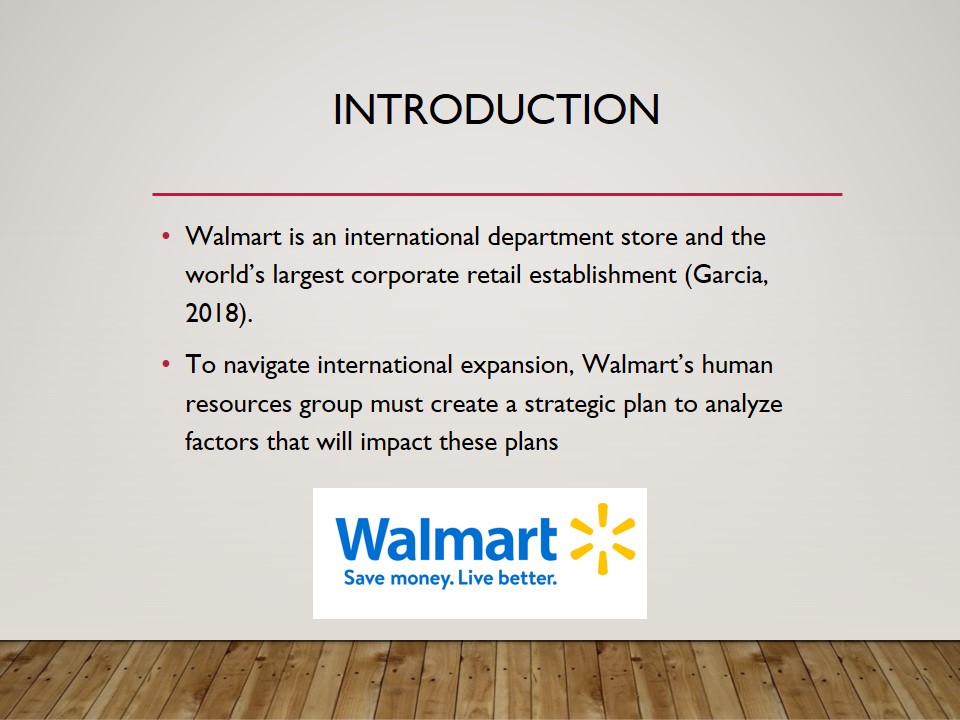
Description of Selected Organization
- Walmart was founded in 1962 by Sam Walton, beginning in a small variety store in Arkansas (Garcia, 2018).
- By 2018, Walmart employed over 2.3 million workers across the world.
- Ranging from Botswana to Zambia, Walmart has made their mark on the international market.
Today, Walmart operates approximately 11,500 stores under 56 banners in 27 countries and eCommerce websites in 10 countries. We employ approximately 2.2 million associates around the world – 1.5 million in the U.S. alone (Walmart, 2020). Walmart has become a model of consistency of a company that can expand internationally and still be profitable. If the company aims to do business in a country that is close to the U.S., high in population, and easily marketable, Walmart should look to expand to Mexico.
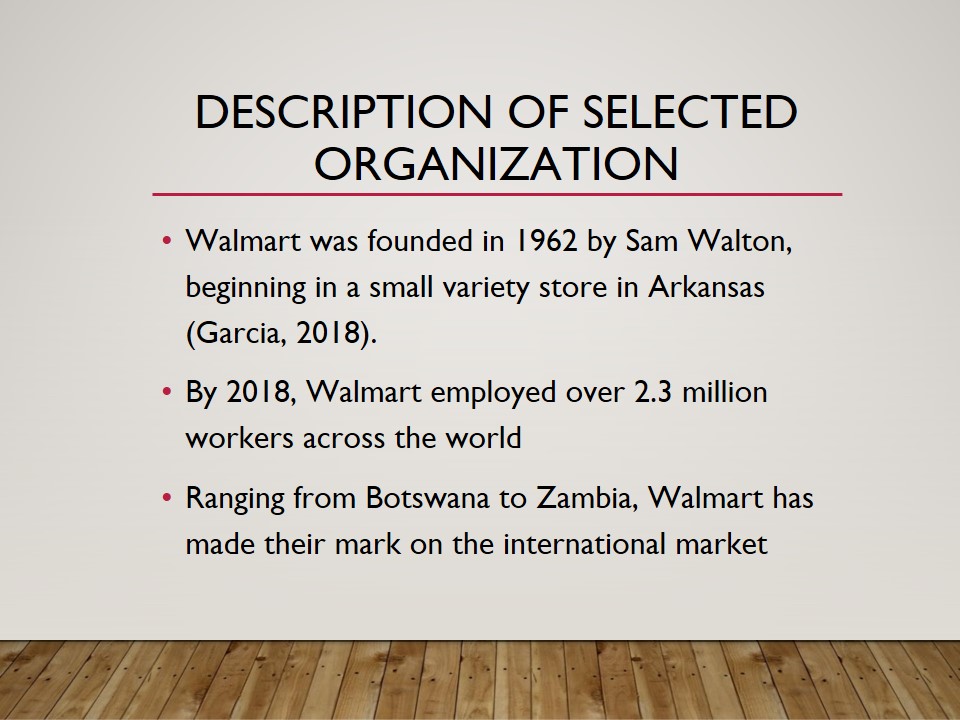
The Four Factors That Affect HRM in International Markets
- Cultural Dimensions.
- Education-Human Capital Dimensions.
- Economic Systems.
- Political-Legal Systems.
Cultural dimensions are a factor that can affect the coordination and communication of an organization (Noe, Hollenbeck, Gerhart, & Wright, 2014). Education-Human capital dimensions, economic systems and political-legal systems all represent the potential challenges of international expension for an HRM group. It is important to analyze every aspect of the respected international market that you are intending to go to because cultural and societal norms, business acumen, legality and ethical matters may be different than those of your own country.
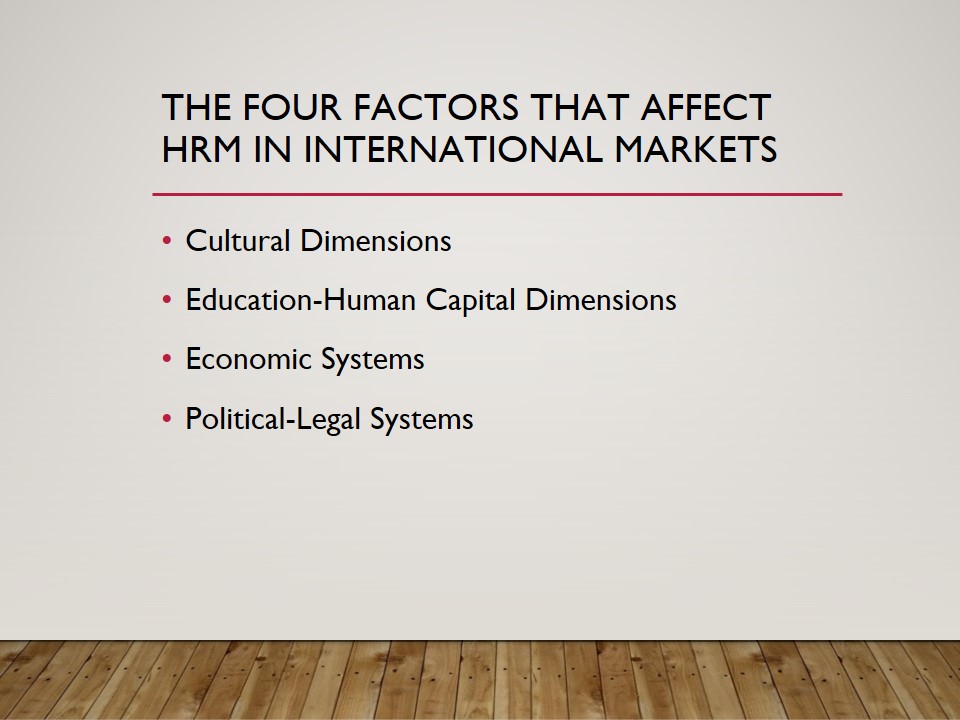
Discussion of How the Four Factors Affect HRM in International Markets
Cultural Dimensions
The differences of nations play a significant role in forming the organization’s cultural values and work process.
- examples:
- the individualist state of mind values career opportunities.
- collectivist societies appreciate the possibility of belonging to an influential group.
- feminine cultures are positive about short and well-defined working hours.
- masculine ones focus on the ability to compete successfully (Gravili & Fait, 2016).
Education-Human Capital Dimensions
The work process should be adjusted to the level of education provided by the local educational system.
- Toyota example (partnered with the secondary education system to train and select future workers immediately after graduation);
- General Motors upholstery facility in Mexico employs low-skilled workers, while IBM’s R&D employs skilled physicists in Switzerland (Fourie, 2016).
Economic Systems
multinational companies often have to connect their pay systems to the host country’s labor market needs.
- minimum wage;
- benefits;
- cost of living abroad;
- living conditions;
The organization of the training process and personnel development also requires expanded costs.
Political- Legal Systems
- the spendings of developing a unified legal framework;
- the culture and regulations of the home country of the company may conflict with the culture and laws of the recipient.
The differences of nations play a significant role in forming the organization’s cultural values and work process. Such beliefs borrowed from the corporate and professional culture of individuals have an additional impact. For instance, the individualist state of mind values career opportunities. Collectivist societies appreciate the possibility of belonging to an influential group. Feminine cultures are positive about short and well-defined working hours, while masculine ones focus on the ability to compete successfully (Gravili & Fait, 2016). Cultures with low uncertainty avoidance pay attention to work diversity (Gravili & Fait, 2016). A contraindication to work as an international manager is ethnocentrism. This approach leads to the desire to implement another culture’s representatives into the frameworks and to expect and demand from them the behavior corresponding to these norms.
The human capital of an organization is the combined capabilities, professional experience and skills, work motivation, and knowledge of employees that give the organization its distinctive character and can be used to generate income. In addition, HR needs to take into account the synergistic effect that manifests itself in a unique management system and organizational culture.
The work process should be adjusted to the level of education provided by the local educational system. The most prominent example is the Toyota company (Ngcobo et al., 2019). Like other large Japanese corporations that follow the tradition of life-long employment, they succeed in hiring the matchable people for their factories and offices. In Japan, Toyota has partnered with the secondary education system to train and select future workers immediately after graduation. However, this approach is not applicable in all countries where Toyota operates because local school systems are often not ready for such partnerships with individual firms. In Germany, the secondary education system provides students with extensive vocational training, but it is not as focused as Japan. In contrast, US public schools focus on general education and have limited training opportunities. Besides, in many countries, there is an entirely uneducated and unskilled labor force. In this regard, Toyota has adjusted its recruitment, selection, and training practices to meet each country’s requirements.
Each country has its characteristics of labor force structure and costs, and multinational companies can benefit from having access to the workforce of different countries. For example, the General Motors upholstery facility in Mexico employs low-skilled workers, while IBM’s R&D employs skilled physicists in Switzerland. When companies look to overseas resources or markets, the same product can be manufactured in different ways due to differences in labor markets.
Working conditions and living wages can vary considerably, so multinational companies often have to connect their pay systems to the host country’s labor market needs. They should be aware of local laws that may require minimum wages or require companies to provide workers with certain benefits, such as annual bonuses or health insurance. Moreover, managers must determine how to pay executives working overseas, potentially facing a higher cost of living, worsening living conditions, and the stress of being separated from friends and family.
Moreover, the organization of the training process and personnel development also requires expanded costs. Considerations should be given to the expenditures associated with teaching the country’s language, culture, national traditions, and customs. The costs pay off since an international company uses cross-cultural resources as an influential factor in its development. The expenses incurred for the formation of organizational culture and human capital development in an international company are economically justified. It helps to increase the economic efficiency of the company as a whole, raising the level of the company’s competitiveness, as well as being the basis for the success of its strategic development.
The costs of forming the organizational structure should include the spendings of developing a unified legal framework since the laws for doing business in different countries can differ significantly. It is especially complicated when the culture and regulations of the home country of the company conflict with the culture and laws of the recipient.
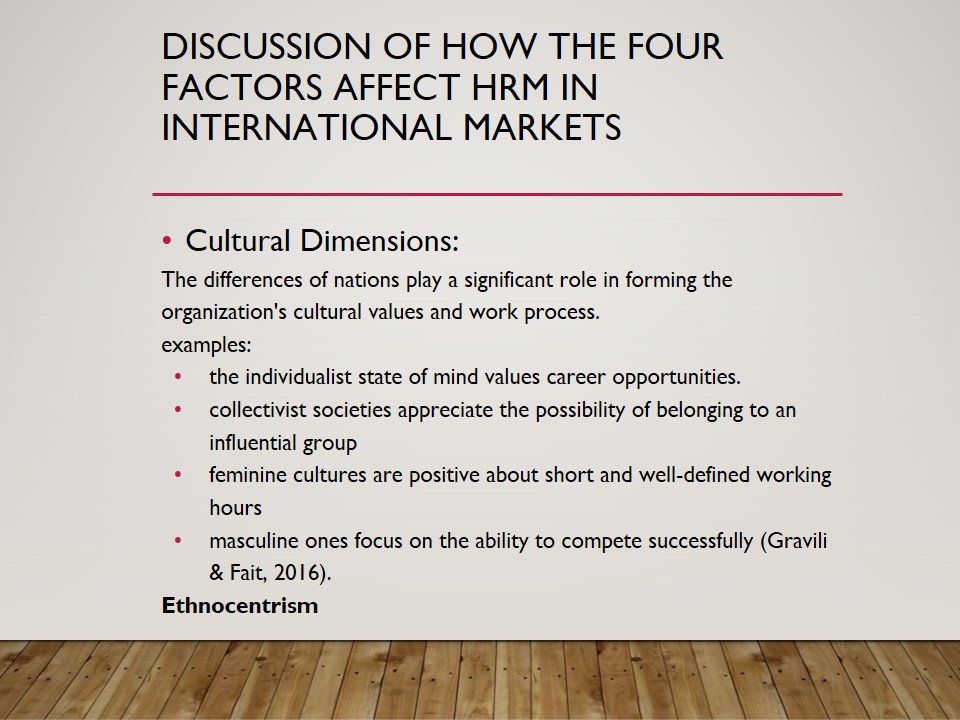
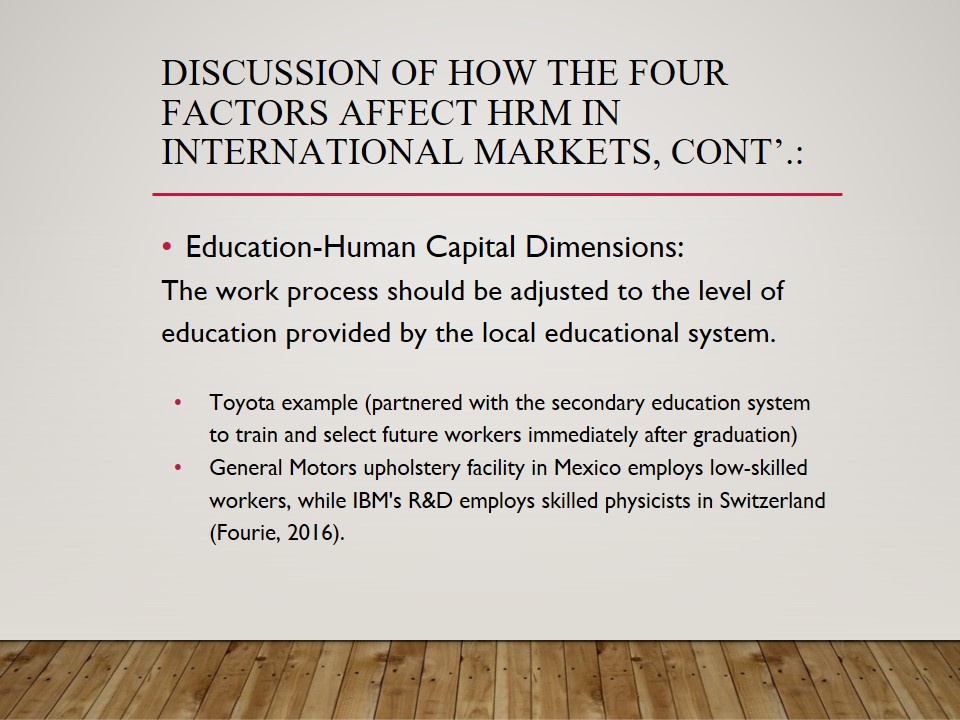
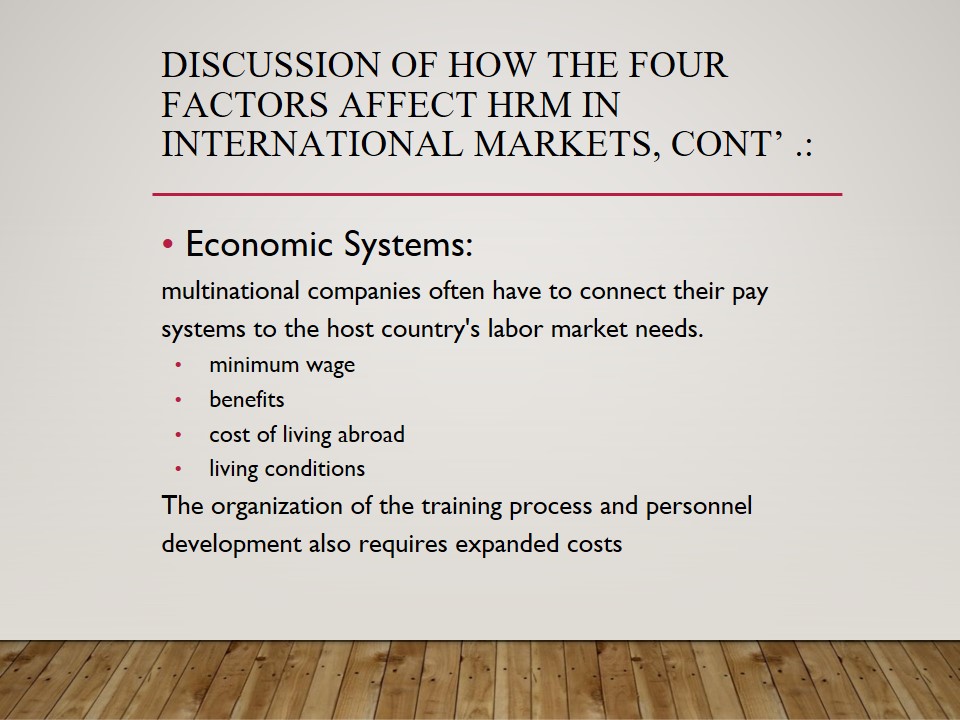
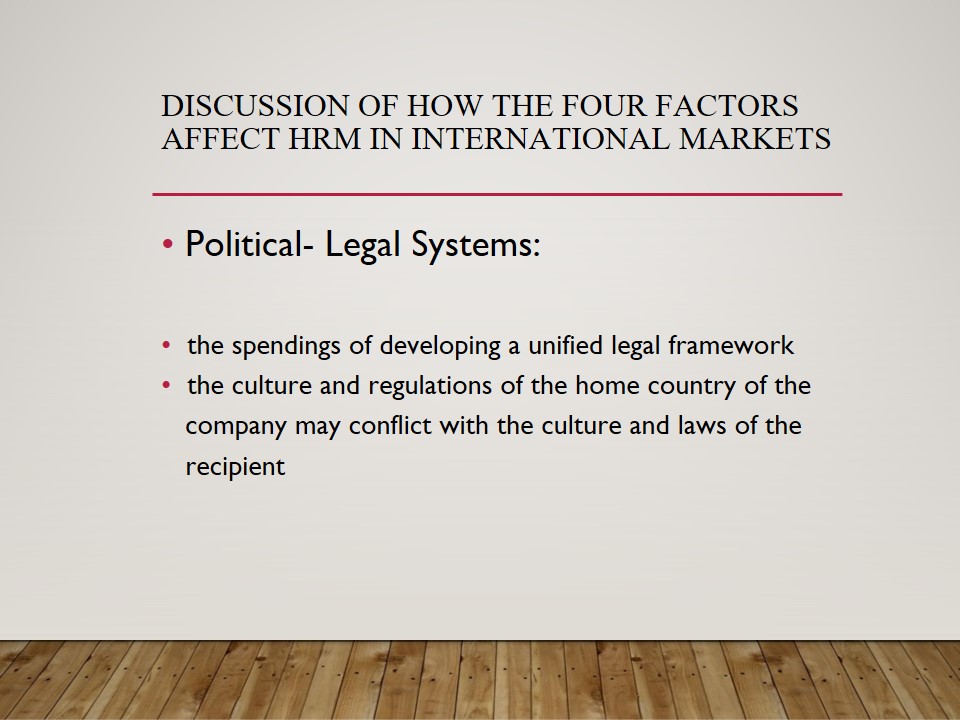
Selection of Expatriate Managers
- An expatriate is an individual who works in a country other than their own (Noe, Hollenbeck, Gerhart, & Wright, 2019).
- Many up and coming executives use these programs as a mean to gain additional experience, although due to the recession there has been a refocus of candidates (Russwurm, Hernandezm Chambers, & Keumyong Chung, 2011).
- Walmart relied on the expat assignments in order to help leaders grow, but now instead focuses on people who can stay for extended periods of time (Russwurm, Hernandezm Chambers, & Keumyong Chung, 2011).
- Selection of expatriate managers can be a tool in order to provide executives experience with cultural norms or political environments (Noe, Hollenbeck, Gerhart, & Wright, 2019).
- Selections of expatriate managers has also shifted to short term assignments in which a person is selected to go and aid in solving a certain problem (Russwurm, Hernandezm Chambers, & Keumyong Chung, 2011).
Expatriate Managers are those who work in a country that is not their place of birth, the most frequent countries to participate in this practice are the United States, China, Africa, and India (Noe, HollenBeck, Gerhart, & Wright, 2019). Selection of expatriate managers used to be considered a rite of passage as well as a requirement in order to be an executive, but times have changed this mentality (Russwurm, Hernandezm Chambers, & Keumyong Chung, 2011). Now leaders are selected for expac assignments so they will spend several years truly immersing in the culture also allowing them to settle for two to three years (Russwurm, Hernandezm Chambers, & Keumyong Chung, 2011).
Many managers used to be selected for expatriate assignments so they could gain experience and knowledge in different cultures allowing them to understand and impact the business within the given market (Noe, Hollenbeck, Gerhart, & Wright, 2019). Selection has also shifted to short term assignemnts in which managers will go to a certain country on a expatriate assignment to help solve a certain problem or situation (Russwurm, Hernandezm Chambers, & Keumyong Chung, 2011).

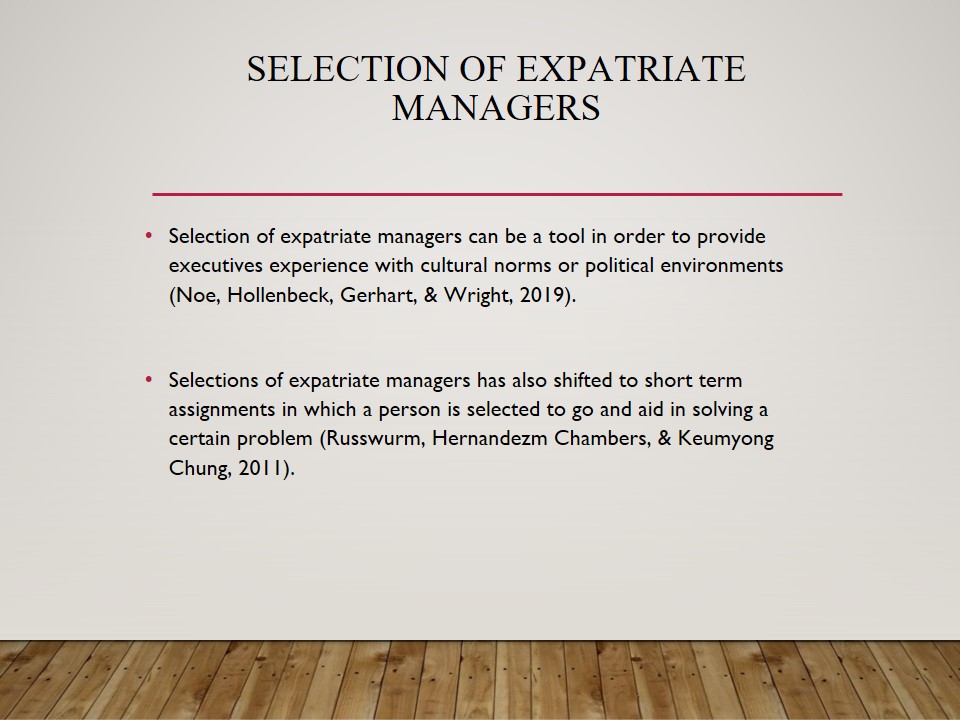
Training and Development of Expatriates
- Many factors play into the success of a person when it pertains to expatriate assignments and several phases impact the effectiveness.
- An individual must be competent in their field, they must have solid communication skills, flexible, and motivated (Noe, Hollenbeck, Gerhart, & Wright, 2019).
- Several training techniques are utilized, and the families are included in the training as they are a pivotal part to the managers success (Noe, Hollenbeck, Gerhart, & Wright, 2019).
Cross-cultural preparation is the system of educating employees, so they can successfully transition to a foreign country (Noe, Hollenbeck, Gerhart, & Wright, 2019). The training for expatriates’ candidates is one that has many phases in which must be executed successfully so the manager can be successful. Most businesses place a focus on the development of the individual which often leads to the manager failing, for a person to be successful a focus must be placed on preparing them for the culture they are about to join (Noe, Hollenbeck, Gerhart, & Wright, 2019). The predeparture phases is where a large majority of the training takes place. This phase includes language training, intro the countries cultures and customs, and can even include the family of the manager (Noe, Hollenbeck, Gerhart, & Wright, 2019). This training includes presentation, lectures, and actual immersion experiences (Noe, Hollenbeck, Gerhart, & Wright, 2019).
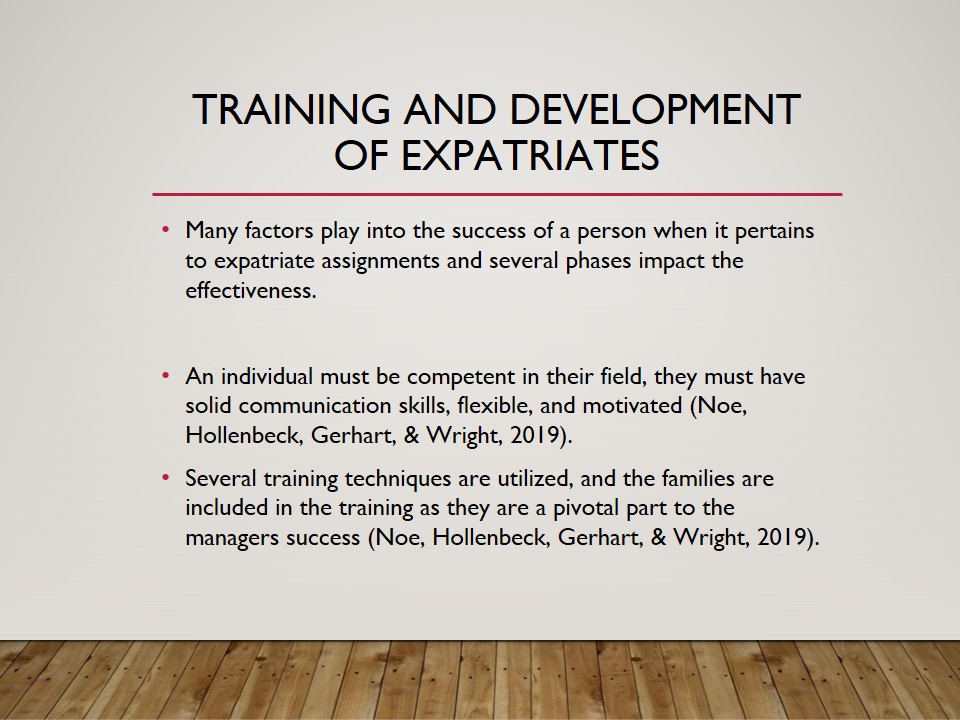
Compensation and Employee Benefits Offered
- Most promotions come from within the organization.
- Full and part time employees are eligible for quarterly bonuses based on store performance.
- Continued Education opportunities are offered to the employee at just $1 per day and Wal-Mart picks up the remaining balance.
- 401K match up to 6% starting day one of employment.
- 10% discount at all Wal-Mart locations.
Wal-Mart offers several benefits and perks to being an employee outside of just monetary compensation. Between the part-time and full-time employees, the average Wal-Mart employee makes around $18,000 per year (Tarpinian, 2005). Based on store performance, all employees are eligible for quarterly bonuses which cost nearly $800 million in 2019 (Walmart, 2020). Though Wal-Mart’s pay is relatively low compared to some of the other larger retailers, the organization makes up for it with many other perks which are sure to save employees money. For those wishing to better their career, there are several college options offered where for only one dollar per day an employee can work toward a degree in business or supply chain management (Walmart, 2020). Other perks include 401k retirement assistance as well as discounts all at Wal-Mart locations. The organization uses low hourly wages and yearly salaries to keep the organization profitable, though offers benefits many other organizations in this salary range would not be able to supply.
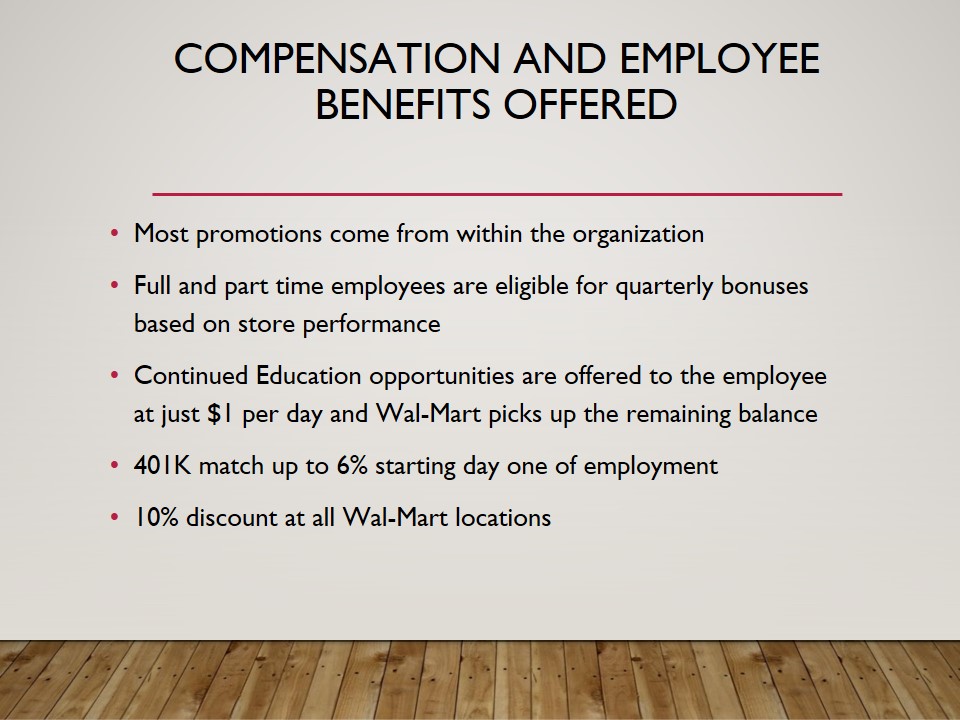
Conclusion
Intercultural competence includes understanding the nature of culture and ways of how culture affects a person’s behavior in the workplace. Awareness of the differences between nations and their features influences the organization of structures, systems, and priorities.
This study confirms that an international company with a developed organizational culture and a well-built human resource management system is more successful and competitive than companies that do not pay sufficient attention to the development of intangible resources.
All international companies face severe problems in recruiting. The influence of cross-cultural interaction is of particular importance. Employees, bearers of their national culture, bring their traditions, norms, and values to the organizational culture, which should be considered when forming a shared corporate culture.
To implement management technologies and techniques in today’s world, an employee of a company must have cross-cultural skills, that is, the ability to demonstrate consistent behavior in a foreign or mixed cultural environment, leading to the achievement of goals. Intercultural competence includes understanding the nature of culture and ways of how culture affects a person’s behavior in the workplace. Awareness of the differences between nations and their features influences the organization of structures, systems, and priorities. It brings positive outcomes to the ability to integrate elements of one culture into another and understand how deeply aspects of one culture can be embedded into another, and vice versa.
The universalization of an international company’s products and its adaptability to any cultural environment ensure the active promotion of a global, transnational company in the world market. This study confirms that an international company with a developed organizational culture and a well-built human resource management system is more successful and competitive than companies that do not pay sufficient attention to the development of intangible resources.
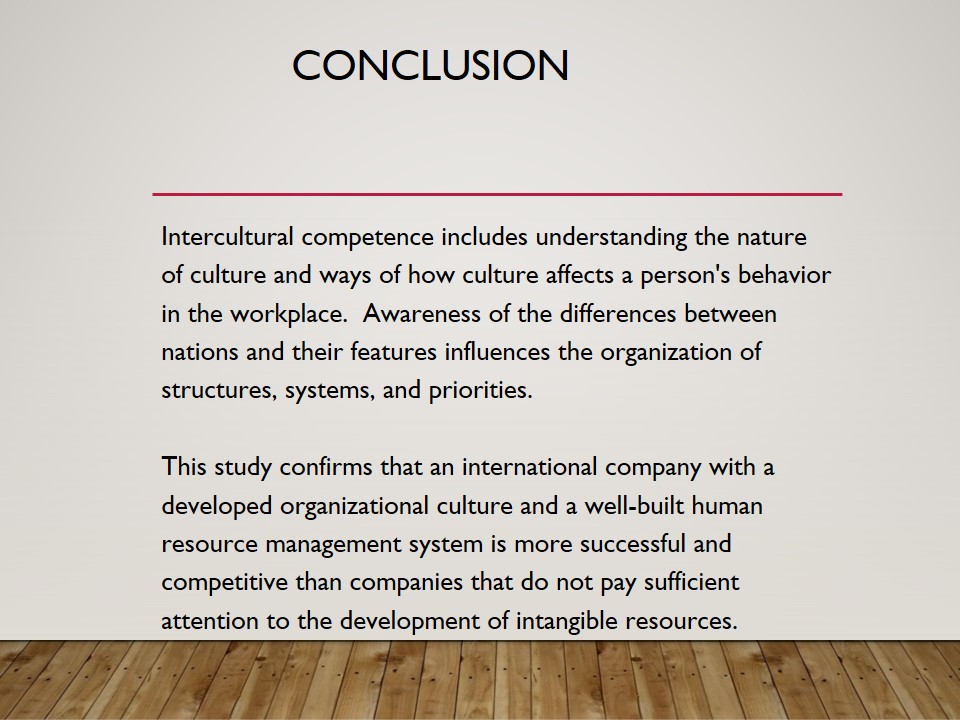
References
- García, J. D., PhD. (2018). Walmart. Salem Press Encyclopedia. Web.
- Noe, R. A., Hollenbeck, J. R., Gerhart, B., & Wright, P. M. (2019). Human resource management: Gaining a competitive advantage(11th ed.). New York, NY: McGraw-Hill/Irwin.
- Russwurm, S., Hernandez, L., Chambers, S., & Keumyong Chung. (2011). Developing Your Global Know-How. Harvard Business Review, 89(3), 70–75.
- Walmart Corporate (2020). Walmart Our Locations. Web.
- Walmart Corporate (2020). Walmart Working at Walmart. Web.
- Tarpinian, G. (2005). Low Wage Nation. New Labor Forum (Routledge), 14(1), 28.
- Fourie, L. F. (2016). On a Global Mission: The Automobiles of General Motors International Volume 3. FriesenPress.
- Gravili, G., & Fait, M. (2016). Social recruitment in HRM: a theoretical approach and empirical analysis. Emerald Group Publishing.
- Ngcobo, T., Martins, A., & Martins, I. (2019). Talent Management: Retaining Distinctive Human Capital Sustainably. In Dall’Acqua, L. (Ed.), Forecasting and Managing Risk in the Health and Safety Sectors (pp. 145-174). IGI Global.